stranded fin whale
Burien fin whale skeleton gets new life for public display
Jun/28/15 06:50 AM
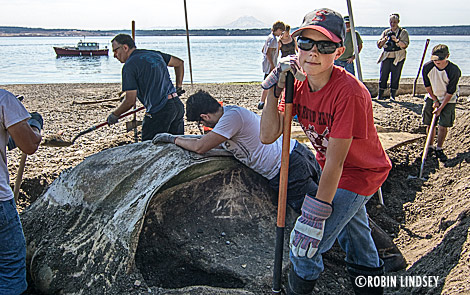
The endangered whale was killed by a ship strike, likely brought into Puget Sound on the bow of a large ship, and floated ashore at Burien’s Seahurst Park in April of 2013. Seal Sitters volunteers assisted in crowd control as hordes of people flocked to the park to view the second largest species of whale - and animal - in the world. Following a limited necropsy by Cascadia Research Collective and Washington Department of Fish and Wildlife/Marine Mammal Investigations Unit, the carcass was towed to a South Puget Sound island for further examination and left to naturally decompose on the remote beach.
Next began the search to find an institution interested in the bones for an educational display. Foss Waterway Seaport, located on Tacoma’s waterfront, jumped at the opportunity to feature the huge skull and other bones at their museum. Although the skeleton was incomplete because the whale was literally cut in half by the ship, Seaport Director of Education, Jan Adams, believed the skull would prove a wonderful learning experience.
Brainstorming with her 14-year old son Gregg about possible Eagle Scout service projects, WDFW’s marine mammal biologist Dyanna Lambourn asked if he might want to lead his troop in unearthing the whale. Gregg presented the idea to his fellow Scouts who enthusiastically agreed to help with the unique endeavor. After substantial planning, the complex service project was approved by leadership in the Chief Seattle Council. In 2013 alone, members of the Boy Scouts of America, working toward achieving the rank of Eagle Scout, donated 9.3 million service hours on projects that benefited communities across the country.
On Friday night, 6 Scout team leaders (along with the Scoutmaster and adult leaders) camped out in the woods of the island, preparing for the big dig. In the early morning light, the remaining 5 Scouts from the troop (ages 11-14) were shuttled across the water from Fox Island by WDFW in a pair of sturdy Boston Whaler research boats. A handful of volunteers from Highline College’s Marine and Science Technology (MaST) later arrived with Foss Waterway staff on a refurbished U.S. Coast Guard research vessel which chugged all the way from Tacoma. Eggs were scrambled for breakfast burritos and coolers full of water, Gatorade and food for the day were lined up for the crew.
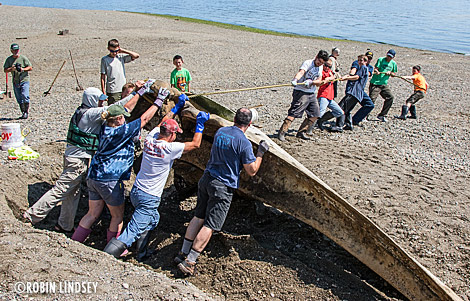
The team tugged and pushed the estimated 1,000 lb skull and its lower two jaws, each weighing more than 500 lbs, to the water’s edge. A barge from Nisqually Marine Services, requiring only an 18” depth of water and equipped with a crane, raised the mammoth bones up onto the deck for transport to the museum where they will be scrubbed clean, dried and prepped for exhibition.
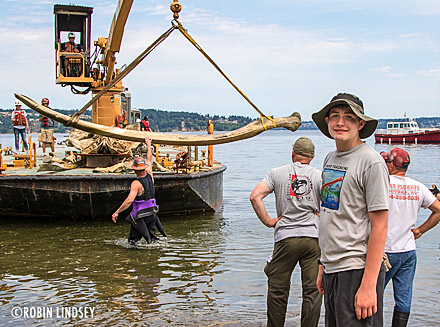
Once on display at Foss Seaport Waterway’s museum (hopefully by late July), the bone artifacts will educate scores of visitors about majestic fin whales - and the increasing dangers of ship strikes to the many species of whales who migrate along our Pacific Coast.
Dead fin whale comes ashore on Washington coast
Jun/14/13 11:48 AM
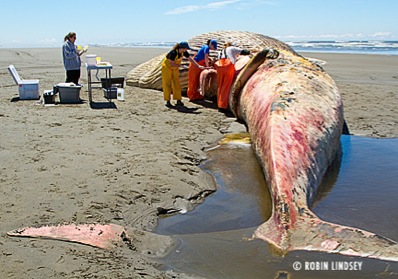
The adult male whale was moderately decomposed with most of the skin missing. The lower jaw of a fin whale has an asymmetrical coloration of the baleen (black on the left side and creamy white on the right side), a physical characteristic of this species which aided in the identification of the whale. There was significant bruising and evidence of blunt force trauma consistent with a ship strike.
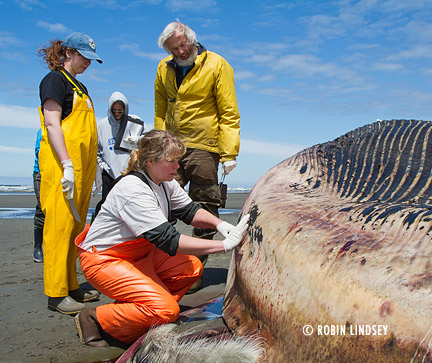
Dangers still exist for fin whales, however, as ships move through krill feeding grounds where the whales forage near the surface - easy victims for ship strikes. This is the second fin whale to wash ashore this year on Washington beaches, both attributed to ship strikes.
NOTE:
Responses such as the one yesterday by members of NOAA’s Northwest Marine Mammal Stranding Network rely on critical funds from the John H. Prescott Marine Mammal Rescue Assistance Grant. Recently Prescott funding was slashed from $4 million (for the entire nation) to a mere $1.4 million. Additionally, it has been eliminated completely from the proposed 2014 Federal Budget. These grants fund the scientific research necessary to monitor the health of our marine ecosystem and ensure timely response by groups all across the US to protect both marine mammals and the public. Read more about this essential program and how to contact your congressional representatives to restore Prescott funds.
Dead fin whale successfully towed to remote location
Apr/17/13 07:26 AM
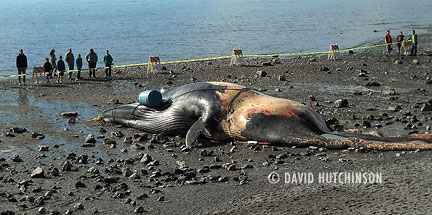
We received a call yesterday morning from NOAA NW MMSN stranding expert Kristin Wilkinson, inquiring if our volunteers could assist neighboring stranding network MaST (which covers south of Brace Point to Redondo) that afternoon on the Burien beach. We replied with an enthusiastic yes. Kristin said the logistics of removing the dead fin whale from the beach had been worked out and there was a need for volunteers to inform the public about the process and for crowd control. Global Diving and Salvage, hired by the City of Burien, would arrive in the afternoon to harness the huge animal, now resting high on the beach, prepare the whale for removal and return at high tide late in the night. The animal would then be towed to an island in South Puget Sound.
Seal Sitters volunteers arrived on scene at 1pm to find the perimeter (established by Parks on Monday after a mob scene the day before, fueled by tv coverage of the stranding) torn down in one area and the whale surrounded by people inside the “danger - do not enter” tape. Seal Sitters David and Buzz managed to move the crowd safely away and re-taped the open section of the perimeter near the tail. It is surmised that the whale shifted position at the earlier high tide and the tail broke the tape. Soon after, more SS volunteers arrived along with those from MaST and beach naturalists. Throughout the afternoon, they educated hundreds of curious observers on the biology of endangered fin whales, the dangers of ship strikes and the logistical challenges of moving such an immense whale.
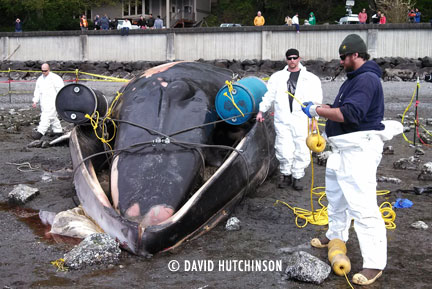
The salvage company returned at about 10 pm last night and the tow was underway. Seal Sitters received word at 7:30 this morning that the whale was secured at the remote location where it will decompose naturally. The skull will be retrieved at a later date for research and educational purposes. This afternoon, members of WDFW-MMI and Cascadia will take more scientific samples.
Congratulations to Kristin, the cooperative efforts of the many stranding network members, beach naturalists and the City of Burien/Parks in this very complicated and demanding task.
Challenging situation to remove dead fin whale from beach
Apr/15/13 01:05 PM
NOAA’s NW Marine Mammal Stranding expert reports that they are working with several groups, including the City of Burien and Burien Parks and Recreation, to find a solution to both crowd control and the removal the fin whale that washed ashore Saturday at Seahurst Park. Large whale strandings are extremely complicated situations, usually taking a minimum of 3-5 days to resolve. Since the backbone and rear half of the whale is missing, towing the whale either to another location for necropsy or to sink in the Sound is difficult. There is no tail fluke to tie rope to and towing the whale by the head causes too much drag for many vessels to handle. With very limited funding for marine mammal strandings, NOAA is working to find an educational or scientific facility interested in obtaining the huge, intact skull and potentially help with the logistics of removal.
After a chaotic Sunday with hundreds of onlookers at the beach (many with young children touching and climbing on the whale), Burien Parks is establishing a tape perimeter with signage, in hopes to keep people safely away from the immense whale. Marine mammals can carry infectious disease. Touching the animal carcass or blood and bodily fluids is inherently dangerous. Please admire this magnificent whale from a safe distance.
ADDITIONAL NOTE 10:26 pm
Like Seal Sitters, most marine mammal stranding networks across the region (and nation) are all-volunteer with little or no funding and paid staff. Some networks are smaller than others and volunteers are not always available. Not every network can have a dawn to dusk presence on site.
Seal Sitters MMSN responds to marine mammals, dead or alive, from Brace Point (just south of the Fauntleroy ferry dock) and all West Seattle shoreline through the Duwamish River (including Harbor Island). If you see a marine mammal on the beach, please call our dedicated hotline 206-905-7325 (SEAL).
After a chaotic Sunday with hundreds of onlookers at the beach (many with young children touching and climbing on the whale), Burien Parks is establishing a tape perimeter with signage, in hopes to keep people safely away from the immense whale. Marine mammals can carry infectious disease. Touching the animal carcass or blood and bodily fluids is inherently dangerous. Please admire this magnificent whale from a safe distance.
ADDITIONAL NOTE 10:26 pm
Like Seal Sitters, most marine mammal stranding networks across the region (and nation) are all-volunteer with little or no funding and paid staff. Some networks are smaller than others and volunteers are not always available. Not every network can have a dawn to dusk presence on site.
Seal Sitters MMSN responds to marine mammals, dead or alive, from Brace Point (just south of the Fauntleroy ferry dock) and all West Seattle shoreline through the Duwamish River (including Harbor Island). If you see a marine mammal on the beach, please call our dedicated hotline 206-905-7325 (SEAL).
Dead fin whale washes ashore in Burien, victim of ship strike
Apr/13/13 11:57 PM
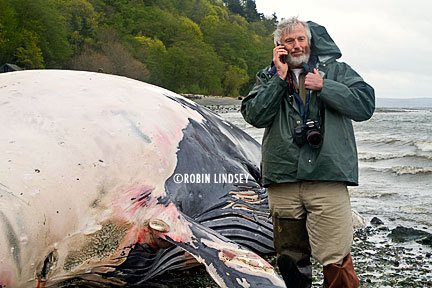
A dead adult fin whale, the apparent victim of a ship strike, washed onto the beach of Seahurst Park mid-morning today. Biologist Dyanna Lambourn and interns from WA Dept. of Fish and Wildlife Marine Mammal Investigations (WDFW-MMI), Cascadia Research biologists John Calambokidis and Jessie Huggins, and staff and students from MaST Center of Highline Community College examined the whale and answered questions from the public. Seal Sitters volunteers participated as well.
Most of the rear half of the whale was missing, but the animal was estimated to have been approximately 65 ft in length when intact. Fin whales are the second largest species of whales with a maximum length of 75 ft. Bruising from brunt force trauma is an indication that the whale was still alive when struck by the bow of a large ship. Red paint from the ship was on the whale’s body. Fin whales, an endangered species, are susceptible to mortal wounds because of their size and their tendency to feed near the water’s surface. Since 2002, Cascadia reports there have been 10 stranded fin whales in Washington waters, 8 of which had evidence of vessel collisions (including today’s whale).
These large baleen whales are vulnerable to ship strikes as they travel in waters along our Pacific coast, particularly in busy shipping lanes such as Los Angeles and Long Beach, California. Gray whales and their calves migrate from Baja California to Alaska through these containership congested waters. Blue whales, the largest of all cetaceans and listed as endangered, are in peril of deadly collisions as they forage on krill in the shipping lanes. In 2007, three blue whales were struck and killed by ships in the Santa Barbara Channel.
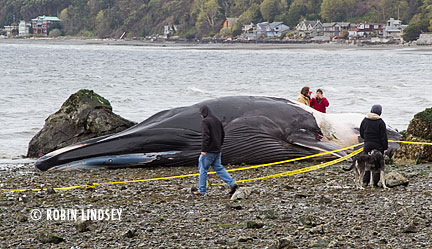
The WDFW-MMI and Cascadia team is making efforts to have the animal towed to a remote location for necropsy. Read Cascadia’s preliminary report here. Studies by both Cascadia and WDFW-MMI on whales and vessel interactions can be found on Cascadia’s website.
Responses such as this by members of NOAA’s NW Marine Mammal Stranding Network are in large part funded by the John H. Prescott Fund, which has been eliminated from the 2014 fiscal year Federal budget. Contact your congressional representative here, asking that this critical funding be restored.
RELATED NEWS MEDIA LINKS
KING 5 TV
KOMO 4 TV
UPDATE 4/15/13
NOAA’s NW Marine Mammal Stranding expert reports that they are working with several groups, including the City of Burien and Burien Parks and Recreation, to find a solution to both crowd control and the removal the fin whale at Seahurst Park. Large whale strandings are extremely complicated situations, usually taking 3-5 days to resolve. Since the backbone and rear half of the whale is missing, towing the whale either to another location for necropsy or to sink in the Sound is difficult. There is no fluke to tie rope to and towing the whale by the head causes too much drag for most vessels to handle. NOAA is trying to find an educational or scientific facility interested in obtaining the skull.
After a chaotic Sunday with hundreds of onlookers at the beach, many touching and climbing on the whale, Parks is establishing a tape perimeter with signage, in hopes to keep people safely away from the immense whale. Marine mammals can carry infectious disease. Touching the animal carcass or blood and bodily fluids is inherently dangerous. Please admire this magnificent whale from a safe distance.







